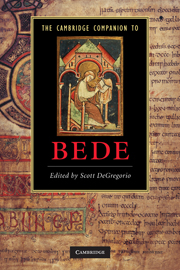Book contents
- Frontmatter
- Part I Bede’s Life and Context
- 1 Bede’s life in context
- 2 Secular and political contexts
- 3 The world of Latin learning
- 4 Church and monastery in Bede’s Northumbria
- 5 British and Irish contexts
- 6 The foundation of Bede’s Wearmouth-Jarrow
- Part II Bede's Writings
- Part III Reception and Influence
- Further reading
- Bibliography
- Index
4 - Church and monastery in Bede’s Northumbria
from Part I - Bede’s Life and Context
Published online by Cambridge University Press: 28 January 2011
- Frontmatter
- Part I Bede’s Life and Context
- 1 Bede’s life in context
- 2 Secular and political contexts
- 3 The world of Latin learning
- 4 Church and monastery in Bede’s Northumbria
- 5 British and Irish contexts
- 6 The foundation of Bede’s Wearmouth-Jarrow
- Part II Bede's Writings
- Part III Reception and Influence
- Further reading
- Bibliography
- Index
Summary
By his own account, Bede inhabited a world of limited horizons. In the oft-quoted autobiographical statement with which he concluded his Ecclesiastical History of the English People, he claimed to have lived all his life from the age of seven in the monastery of St Peter and St Paul which is at Wearmouth and Jarrow (V. 24). He thus viewed the Church in Northumbria not just through the lens of a monastery located on the eastern coast of the northern Northumbrian kingdom of Bernicia, but from a distinctive perspective within an exceptional religious community, one that arguably did not typify other monasteries of his day. When previously surveying the state of the whole English Church at the time of writing the Ecclesiastical History (c. 731), Bede had explained the wider institutional framework in which his own monastery lay: 'At the present time there are four bishops in the kingdom of Northumbria, over which Ceolwulf rules: Wilfrid in the church of York, Æthelwold at Lindisfarne, Acca at Hexham, Pehthelm in the place called Whithorn . . .' (V. 23, p. 559). Of those bishops, Bede was, not surprisingly, closest to his own diocesan, Acca, the dedicatee of several of his commentaries with whom he maintained a regular correspondence. Yet it is clear from the preface to the Ecclesiastical History that Bede had connections elsewhere within the English ecclesiastical hierarchy, in other Anglo-Saxon monasteries and beyond.
- Type
- Chapter
- Information
- The Cambridge Companion to Bede , pp. 54 - 68Publisher: Cambridge University PressPrint publication year: 2010
- 1
- Cited by



